|
|
| |
|
|
| |
|
|
|
|
| |
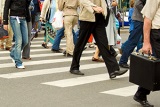 Climate
Impacts on Society Climate
Impacts on Society
Overview
As a society, we have structured our day-to-day lives around
historical and current climate conditions. We are accustomed
to a normal range of conditions and may be sensitive to
extremes that fall outside of this range. |
 Climate
change could affect our society through impacts on a number
of different social, cultural, and natural resources. For
example, climate change could affect human health,
infrastructure, and transportation systems, as well as
energy, food, and water supplies. Climate
change could affect our society through impacts on a number
of different social, cultural, and natural resources. For
example, climate change could affect human health,
infrastructure, and transportation systems, as well as
energy, food, and water supplies.
Picture - The
percentage change in population across the United States
from 1970 to 2008. In recent decades, population has grown
rapidly in coastal areas and in the southern and western
regions of the United States. Source: USGCRP (2009)
Some groups of people will likely face greater challenges
than others. Climate change may especially impact people who
live in areas that are vulnerable to coastal storms,
drought, and sea level rise or people who live in poverty,
older adults, and immigrant communities. Similarly, some
types of professions and industries may face considerable
challenges from climate change. Professions that are closely
linked to weather and climate, such as outdoor tourism,
commerce, and agriculture, will likely be especially
affected. |
|
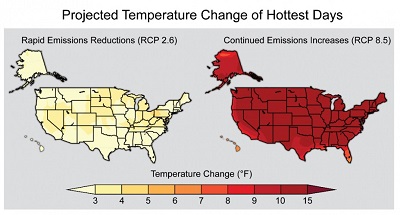 Impacts
on Vulnerability and Equity Impacts
on Vulnerability and Equity
Projected climate change will affect certain groups of
people more than others, depending on where they live and
their ability to cope with different climate hazards. In
some cases, the impacts of climate change are expected to
worsen existing vulnerabilities.
Picture - The average
temperature on the hottest days (i.e., those that occur only
once in 20 years) are projected to increase by the end of
the century relative to 1986-2005. Those days will be 10°F
to 15°F hotter under the ”continued emissions increases”
scenario by 2100. USGCRP (2014)
Geographic Location
Where people live influences their vulnerability to climate
change.
Over the past four decades, population has grown rapidly in
coastal areas and in the southern and western regions of the
United States. These areas are most sensitive to coastal
storms, drought, air pollution, and heat waves.
Populations in the Mountain West will likely face water
shortages and increased wildfires in the future.
Arctic residents will likely experience problems caused by
thawing permafrost and reduced sea ice.
Along the coasts and across the western United States, both
increasing population and changes in climate place growing
demands on transportation, water, and energy infrastructure. |
|
|
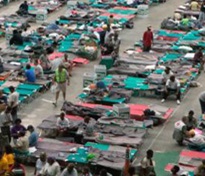 Ability
to Cope Ability
to Cope
Different groups have different abilities to cope with
climate change impacts.
Picture - Thousands of
New Orleans evacuees relocated to the Houston Astrodome
after Hurricane Katrina in 2005. Source: FEMA (2005)
People who live in poverty may have a difficult time coping
with changes. These people have limited financial resources
to cope with heat, relocate or evacuate, or respond to
increases in the cost of food.
Older adults may be among the least able to cope with
impacts of climate change. |
|
|
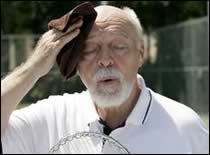 Older
residents make up a larger share of the population in warmer
areas of the United States. These areas will likely
experience higher temperatures, tropical storms, or extended
droughts in the future. The share of the U.S. population
composed of adults over age 65 is also projected to grow
from 13% in 2010 to 20% by 2050. Older
residents make up a larger share of the population in warmer
areas of the United States. These areas will likely
experience higher temperatures, tropical storms, or extended
droughts in the future. The share of the U.S. population
composed of adults over age 65 is also projected to grow
from 13% in 2010 to 20% by 2050.
Picture - Elderly
people are particularly prone to heat stress. Source: CDC
(2009)
Young children are another sensitive age group, since their
immune system and other bodily systems are still developing
and they rely on others to care for them in disaster
situations.
To find out more about climate change and health, please
visit the Health Impacts & Adaptation page.
Indigenous Peoples
Indigenous communities and tribes are diverse and span the
United States. While each community and tribe is unique,
many share characteristics that can affect their ability to
prepare for, respond to, and cope with the impacts of
climate change. These include:
living in rural areas or places most affected by climate
change (like communities along the coast)
relying on surrounding environment and natural resources for
food, cultural practices, and income
coping with higher levels of existing health risks when
compared to other groups
having high rates of uninsured individuals, who have
difficulty accessing quality health care
living in isolated or low income communities
Climate change can impact the health and well-being of
indigenous tribes in many ways. Climate change will make it
harder for tribes to access safe and nutritious food,
including traditional foods important to many tribes’
cultural practices. Many tribes already lack access to safe
drinking water and wastewater treatment in their
communities. Climate change is expected to increase health
risks associated with water quality problems like
contamination and may reduce availability of water,
particularly during droughts.
By affecting the environment and natural resources of tribal
communities, climate change also threatens the cultural
identities of Indigenous people. As plants and animals used
in traditional practices or sacred ceremonies become less
available, tribal culture and ways of life can be greatly
affected. Learn more about climate change and the health of
indigenous populations.
Urban Populations
City residents and urban infrastructure have distinct
sensitivities to climate change impacts. For example, heat
waves may be amplified in cities because cities absorb more
heat during the day than suburban and rural areas.
Cities are more densely populated than suburban or rural
areas. In fact, about 80% of the U.S. population lives in
urban areas. As a result, increases in heat waves, drought,
or violent storms in cities would affect a larger number of
people than in suburban or rural areas. Higher temperatures
and more extreme events will likely affect the cost of
energy air and water quality, and human comfort and health
in cities.
City dwellers may also be particularly susceptible to
vulnerabilities in aging infrastructure. This includes
drainage and sewer systems, flood and storm protection
assets, transportation systems, and power supply during
periods of peak demand, which typically occur during summer
heat waves. |
|
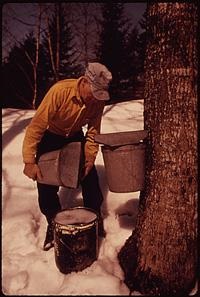 Impacts
on Economic Activities and Services Impacts
on Economic Activities and Services
Certain areas of the United States benefit from being
located close to natural resources that support the local
economy. Climate change could threaten these resources, as
well as the goods and services they produce and the jobs and
livelihoods of those who depend upon them. For example,
climate change will likely affect farming communities,
tourism and recreation, and the insurance industry.
Picture - Sugarmaker
harvesting maple syrup near Randolph Center, VT. Source:
National Archives (1974)
Communities that developed around the production of
different agricultural crops, such as corn, wheat, or
cotton, depend on the climate to support their way of life.
Climate change will likely cause the ideal climate for these
crops to shift northward. Combined with decreasing rural
populations, as in the Great Plains, a changing climate may
fundamentally change many of these communities. Certain
agricultural products, such as maple syrup and cranberries
in the Northeast and grapes for wine in California, may
decline dramatically in the U.S. These crops would then have
to be imported. |
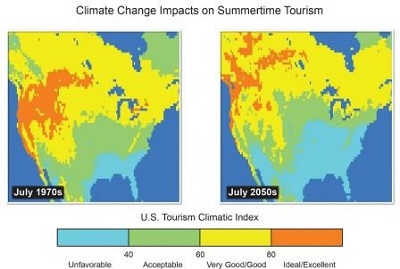 Climate
change will also likely affect tourism and recreational
activities. A warming climate and changes in precipitation
patterns will likely decrease the number of days when
recreational snow activities such as skiing and snowmobiling
can take place. In the Southwest and Mountain West, an
increasing number of wildfires could affect hiking and
recreation in parks. Beaches could suffer erosion due to sea
level rise and storm surge. Changes in the migration
patterns of fish and animals would affect fishing and
hunting. Communities that support themselves through these
recreational activities would feel economic impacts as
tourism patterns begin to change. Climate
change will also likely affect tourism and recreational
activities. A warming climate and changes in precipitation
patterns will likely decrease the number of days when
recreational snow activities such as skiing and snowmobiling
can take place. In the Southwest and Mountain West, an
increasing number of wildfires could affect hiking and
recreation in parks. Beaches could suffer erosion due to sea
level rise and storm surge. Changes in the migration
patterns of fish and animals would affect fishing and
hunting. Communities that support themselves through these
recreational activities would feel economic impacts as
tourism patterns begin to change.
Picture - Summertime
recreation and tourism is projected to become unfavorable
across larger portions of the U.S. by 2050 due to increased
July temperatures and humidity. Source: USGCRP (2014) |
 Climate
change may make it harder and more expensive for many people
to insure their homes, businesses, or other valuable assets
in risk-prone areas, or preclude them from insurance
altogether. Insurance is one of the primary mechanisms used
to protect people and communities against weather-related
disasters. We rely on insurance to protect investments in
real estate, agriculture, transportation, and utility
infrastructure by distributing costs across society and
build resilience. Climate change is projected to increase
the frequency and intensity of extreme weather events, such
as heat waves, droughts, and floods. These changes are
likely to increase losses to property and crops, and cause
costly disruptions to society. Escalating losses have
already affected the availability and affordability of
insurance in vulnerable areas. Climate
change may make it harder and more expensive for many people
to insure their homes, businesses, or other valuable assets
in risk-prone areas, or preclude them from insurance
altogether. Insurance is one of the primary mechanisms used
to protect people and communities against weather-related
disasters. We rely on insurance to protect investments in
real estate, agriculture, transportation, and utility
infrastructure by distributing costs across society and
build resilience. Climate change is projected to increase
the frequency and intensity of extreme weather events, such
as heat waves, droughts, and floods. These changes are
likely to increase losses to property and crops, and cause
costly disruptions to society. Escalating losses have
already affected the availability and affordability of
insurance in vulnerable areas.
Picture - Source: NOAA
National Center for Environmental Information (NCEI) U.S.
Billion-Dollar Weather and Climate Disasters (2016):
https://www.ncdc.noaa.gov/billions/time-series
The graphic above helps to visualize how the different types
of identified U.S. Billion-dollar disaster events have
changed over time. For earlier years, the graphic shows
events with less than $1 billion in damage at the time of
the event, but after adjusting for Consumer Price Index
(inflation), now exceed $1 billion in damages. |
|
|
EPA Page |
|
This is the
EPA page for this topic. To see if the Trump
administration has changed the EPA page, simply click the
link and compare the information with this page. If you
notice changes were made to the EPA page, please post a
comment. Thanks. |
|
|
Key Points
Climate change will affect certain groups more than others,
particularly groups located in vulnerable areas and the
poor, young, old, or sick.
Cities are uniquely sensitive to many impacts, especially
extreme weather impacts.
Climate change may threaten people's jobs and livelihoods. |
|
|
|
|
|
|
|
|
|
|
|
|
Additional Climate Change Information |
Climate Change and Carbon Dioxide
(Beginner - Listening,
reading)
A video lesson to
help with your understanding of climate change
and carbon dioxide.
The English is
spoken at 75% of normal speed.
Great English listening and reading practice. |
Carbon Dioxide and Climate Change
(Beginner - Listening,
reading)
A video lesson to
help with your understanding of carbon dioxide
and climate change.
The English is
spoken at 75% of normal speed.
Great English listening and reading practice. |
Environmental Group Warns Earth's Health at Risk
(Beginner - Listening,
reading)
A video lesson to
help with your understanding of climate change.
The English is
spoken at 75% of normal speed.
Great English listening and reading practice.
A report by the World Wildlife Fund looked at thousands of animal populations
and found they have dropped significantly in 40 years. |
Sea Levels Rising at Fastest Rate in 3,000 years
(Beginner - Listening,
reading)
A video lesson to
help with your understanding of climate change.
The English is
spoken at 75% of normal speed.
Great English listening and reading practice.
A group of scientists say sea levels are rising at record rates. Another group
found that January temperatures in the Arctic reached a record high. |
Capturing CO2 Gas Is Not Easy
(Beginner - Listening,
reading)
A video lesson to
help with your understanding of climate change.
The English is
spoken at 75% of normal speed.
Great English listening and reading practice.
Most scientists agree that carbon-dioxide gas is partly to blame for climate
change: rising global temperatures. But capturing the CO2 gas released by power
stations is costly and difficult. |
Growth, Climate Change Threaten African Plants and
Animals
(Beginner - Listening,
reading)
A video lesson to
help with your understanding of climate change.
The English is
spoken at 75% of normal speed.
Great English listening and reading practice.
Researchers believe Africa may lose as much as 30 percent of its animal and
plant species by the end of this century. |
|
|
|
|
Search Fun Easy English |
|
|
|
|
|
|
|
|
|
|
|
|
|
|
|
About
Contact
Copyright
Resources
Site Map |